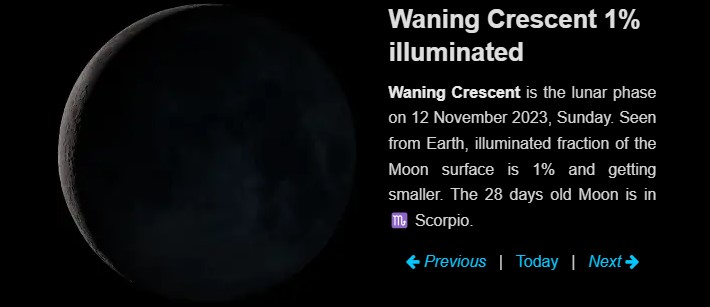Tomorrow Moon Phase November 12 2023: November 12, 2023 On this date, the Moon will be in the Waning Crescent phase, which is optimal for viewing just before sunrise in the western sky. During this phase, the Moon’s illumination gradually diminishes until the New Moon.
As the Moon moves closer to the Sun from the perspective of Earth, only a small portion of the Moon’s surface is illuminated, facing the Earth’s night side. This makes it an ideal time to observe the Moon’s features, such as craters and mountains, as they cast long shadows along the illuminated edge.
Telescopes or binoculars can enhance the viewing experience. To access the daily moon phases for November 2023, please refer to the November 2023 Moon Phases Calendar.
Waning Crescent Phase
The illumination of the Waning Crescent on November 12 is 1%. This percentage signifies the amount of the Moon’s surface that is illuminated by the Sun. The illumination is subject to continuous change and may fluctuate by up to 10% each day.
On November 12, the Moon will be 28.65 days old, indicating the number of days since the previous New Moon. A complete lunar cycle, encompassing all 8 Moon phases, lasts approximately 29.53 days as the Moon orbits the Earth.
Waning Crescent 1% illuminated
Waning Crescent is the lunar phase on 12th Nov 2023, Sunday. Seen from Earth, illuminated fraction of the Moon surface is 1% and getting smaller. The 28 days old Moon is in ♏ Scorpio.
For a comprehensive view of all daily moon phases in November 2023, please visit the November 2023 Moon Phases Calendar.
Moon Phase for Sunday, November 12th, 2023
The Moon phase for November 12th, 2023, will be the Waning Crescent phase. On this day, the Moon will be 28.36 days old and 1.36% illuminated. It will have a tilt of -267.333° and an approximate distance of 391,107.23 km from Earth. The Moon’s astrological sign will be Scorpio.
The Waning Crescent phase of the Moon on November 12th, 2023, signifies that it will be less than 50% illuminated but not yet reached 0% illumination, which would indicate a New Moon. During this part of the Moon’s cycle, it will gradually move closer to the Sun as seen from Earth, with the night side of the Moon facing our planet and only a thin crescent being illuminated.
Related:
The waning (shrinking) crescent Moon will rise around midnight, reach its highest point in the sky after sunrise, and set after noon. The best time to view this phase is 1-2 hours before sunrise, providing an excellent opportunity to observe the Moon’s surface features, including craters and mountains, which cast lengthy shadows along the illuminated crescent.
The Waxing Gibbous phase, like all Moon phases, will last slightly over 7 days, although this duration can vary due to the elliptical shape of the Moon’s orbit. During the Waxing Gibbous phase, the Moon will rise in the east during the mid- to late-afternoon and remain prominently visible in the eastern sky until sunset.
Assuming clear weather conditions, the Waxing Gibbous Moon will continue to be visible throughout most of the night, setting shortly before sunrise. Fun fact: The illuminated side of a waning crescent Moon always faces east, towards the sunrise.


Leave a Reply